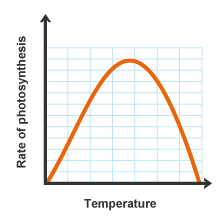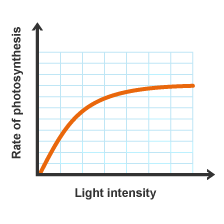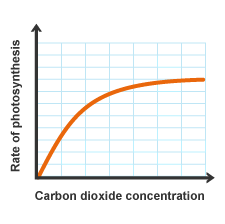- IB Style Question Banks with Solution
- IB DP Biology SL- IB Style Practice Questions with Answer-Topic Wise-Paper 1
- IB DP Biology HL- IB Style Practice Questions with Answer-Topic Wise-Paper 1
- IB DP Biology SL- IB Style Practice Questions with Answer-Topic Wise-Paper 2
- IB DP Biology HL- IB Style Practice Questions with Answer-Topic Wise-Paper 2
2.9 Photosynthesis
Essential Idea:
Photosynthesis uses the energy in sunlight to produce the chemical energy needed for life
Understandings:
- Photosynthesis is the production of carbon compounds in cells using light energy
- Visible light has a range of wavelengths with violet the shortest wavelength and red the longest
- Chlorophyll absorbs red and blue light most effectively and reflects green light more than other colours
- Oxygen is produced in photosynthesis from the photolysis of water
- Energy is needed to produce carbohydrates and other carbon compounds from carbon dioxide
- Temperature, light intensity and carbon dioxide concentration are possible limiting factors on the rate of photosynthesis
Applications:
- Changes to the Earth’s atmosphere, oceans and rock deposition due to photosynthesis
Skills:
- Drawing an absorption spectrum for chlorophyll and an action spectrum for photosynthesis
- Design of experiments to investigate the effect of limiting factors on photosynthesis
- Separation of photosynthetic pigments by chromatograph
- Define photosynthesis.
- State the chemical equation for photosynthesis.
- Define visible light.
- State the relationship between wavelength and energy.
- State the range of wavelengths that fall within the visible spectrum.
- Define pigment.
- State the primary and accessory pigments found in chloroplasts.
- Explain why plants are green.
- Define photolysis.
- State the equation for photolysis.
- State that the oxygen produced in photolysis is a waste product of photosynthesis.
- State the energy conversion that occurs during photosynthesis.
- Define “limiting factor.”
- Explain how the following factors limit the rate of photosynthesis:
- Temperature
- Light intensity
- CO2 concentration
- State that (some) prokaryotes, algae and plants carry out photosynthesis.
- Define and state evidence for the “Great Oxidation Event.”
- Distinguish between an action spectrum and an absorption spectrum.
- Describe the shape of the curve for an absorption spectrum.
- Describe the shape of the curve for an action spectrum.
- List mechanism for measuring the rate of photosynthesis.
- Outline the process of separating pigments using chromatography
- Calculate the Rf value for pigments using pigment chromatography.
- Define independent variable, controlled variable and responding variable.
Define Photosynthesis
It is defined as the process of conversion of light energy into chemical energy. The chemical energy is stored in the form of carbohydrates such as sucrose, starch etc. The reactants of photosynthesis include carbon-dioxide and water and the products are carbohydrates and oxygen. The overall reaction for photosynthesis is given below-
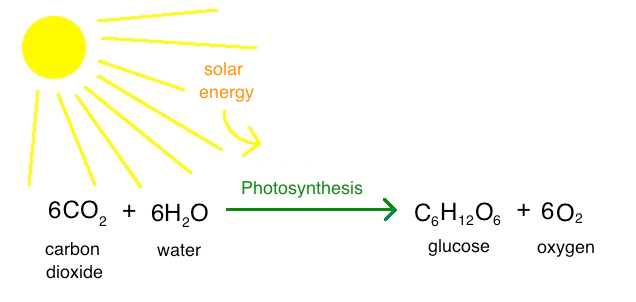
Fig.1. Overall reaction of photosynthesis
Photosynthetic Membranes and Organelles
In higher plants, photosynthesis occurs in chloroplast. Chloroplast is a double membrane structure. There are about 10 to 100 chloroplasts found in plant cell. The outer membrane and the inner membrane are separated by intermembrane space. Membrane enclosed a fluid known as stroma. Stroma contains membrane bound structures known as thylakoid. The stacks of thylakoid are known as granum.
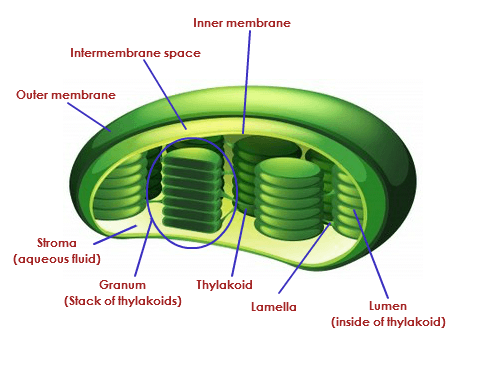
Fig.2. Structure of chloroplasts
One granum is connected to another granum by lamella. Reactions which need light are known as light reactions. The site for light reactions is granum. Light independent reactions are known as dark reactions which takes place in the stroma of the chloroplast.
Pigments involved in Photosynthesis
The pigment present in chloroplast is chlorophyll. Chlorophyll absorbs the sunlight during photosynthesis. It absorbs light mainly from the blue portion of electromagnetic spectrum. Magnesium is the metal ion essential for chlorophyll formation. It comprises of phytol chain and pyrrole ring. Leaves appear green due to the presence of chlorophyll.

Fig.3. Structure of chlorophyll
Other pigments observed during chromatographic separation are – chlorophyll a, chlorophyll b, carotenoids, and xanthophyll. Chlorophyll a appears blue or bright green in paper chromatogram, chlorophyll b appears yellow green, xanthophyll appears yellow and carotenoids appear yellow- orange. Different plant pigments absorb different wavelength of light.
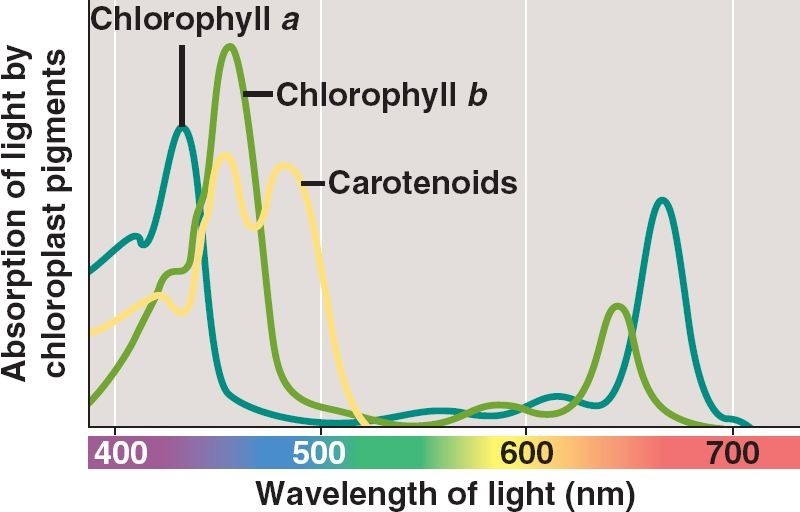
Fig.4. Absorption spectra of different plant pigments
Light Reaction
Light dependent reactions begin with the absorption of photon by the chlorophyll. The pigments are organized into different photosystems. There are two photosystems that are essential for light reactions. Photosystem I (PSI-700) and photosystem II (PSII-680). 700 and 680 represents the absorption spectra for PSI and PSII respectively.
Photosystem comprises of certain proteins, chlorophylls, iron-sulphur centers etc. The single chlorophyll molecule is considered as reaction center where light is absorbed. Light reactions include cyclic photophosphorylation and non-cyclic photophosphorylation.
Non-cyclic photophosphorylation
It includes both the photosystem, that is, PSI and PSII. It begins with the absorption of photon by the PSII which is accompanied by ejection of two electrons. The primary electron acceptor in non-cyclic photophosphorylation is pheophytin. Electrons are then accepted by plastoquinone A (QA) followed by plastoquinone B (QB). Then the electrons are accepted by cytochrome b6f. Then the electrons are accepted by plantocyanin (copper containing pigment). Then PSI accepts the electron and passes to Fe-S center. Then electrons are transferred to Ferredoxin-NADP+ reductase where NADPH is formed.
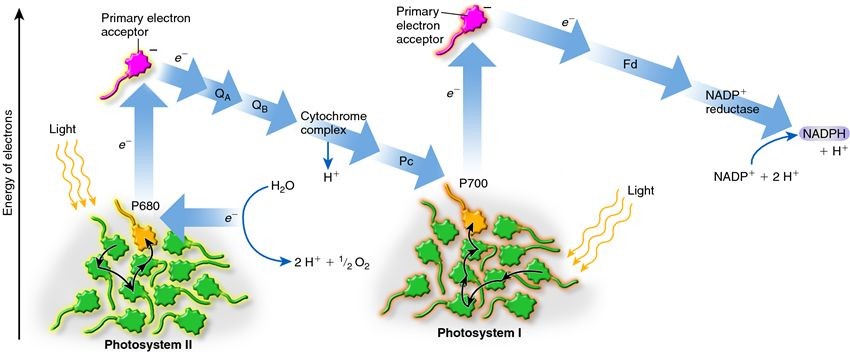
Fig.5. Non-cyclic photophosphorylation
During non-cyclic photophosphorylation protons are also pumped into the thylakoid to create a proton gradient for driving ATP synthesis.
The most important reaction that occurs at PSII is photolysis of water. Manganese, chloride ions are essential for photolysis. It is a light dependent reaction that yields oxygen, proton and electrons.
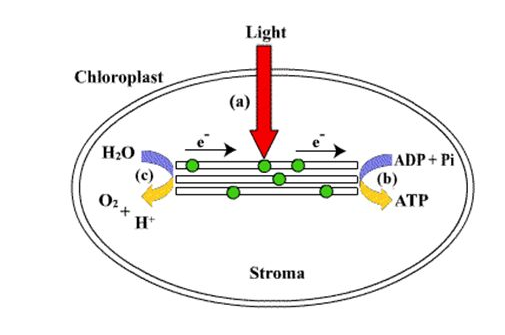
Fig.6. Photolysis of water
Cyclic photophosphorylation
It involves only one photosystem, that is, PSI. During this cycle, electron passes from PSI to primary electron acceptor, pheophytin. Then to cytochrome b6f to plastocyanin before coming back to PSI. There will be no photolysis of water occurs during cyclic photophosphorylation. No NADPH is formed but ATP formation will occur.
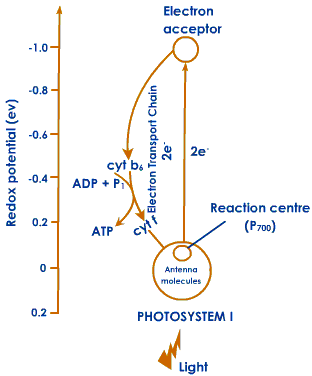
Fig.7. Cyclic photophosphorylation
Difference between Cyclic and non-cyclic Photophosphorylation
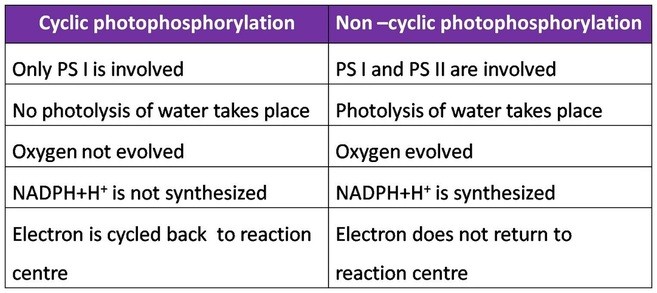
Chemiosmotic Hypothesis
Chemiosmotic hypothesis explains how ATP synthesis occurs. It is based on the hypothesis that Proton gradient drives ATP synthesis. Steps that are involved in setting the proton gradient-
- Splitting of the water molecule (photolysis of water) during light reactions pumps the protons within the lumen of the thylakoid.
- When electrons move through photosystems, protons are pumped across the membrane.
- The NADP reductase enzyme located on the stromal side also pumps the protons across the membrane.
All the above processes are responsible for the establishment of proton gradient. Stroma contain more protons as compared to the lumen of the thylakoid. This also creates a pH difference between the lumen and the stroma. To breakdown the gradient, protons move across the membrane to the stroma through F0-F1 ATPase.
The ATPase enzyme comprises of two parts- Fo which is embedded in the membrane and provides a channel for the pumping of the protons across the membrane. The other part is F1 which faces the stroma and protrudes out of the membrane. Chemiosmosis requires a membrane, a proton pump, a proton gradient, and ATPase complex. Energy is used to pump protons across a membrane, to create a gradient within the thylakoid lumen. ATPase has a channel that allows diffusion of protons back across the membrane which releases enough energy to activate ATPase enzyme that catalyzes the formation of ATP.
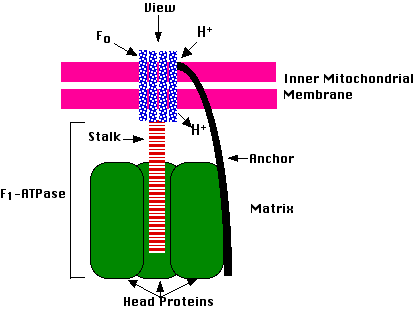
Fig.8. ATPase complex
Calvin Cycle
The ATP and NADPH formed during light reactions are used for the biosynthetic phase of photosynthesis. This phase is known as Calvin cycle or dark phase. It is a light independent reaction that takes place in the stroma of the chloroplast. It is used for the fixation of carbon-dioxide in the form of carbohydrates.
The primary electron acceptor during Calvin cycle is RuBP (ribulose bisphosphate). It has both carboxylase and oxygenase activity. RuBP (a five-carbon substrate) reacts with CO2 in the presence of enzyme RuBisCO to produce 3-PGA (3- phosphoglycerate).
It catalyzes the first reaction of Calvin cycle.
It includes three steps- carbon-fixation, reduction, and regeneration.
- Carboxylation or carbon-fixation include a reaction between carbon-dioxide RuBP to form two molecules of 3-phosphoglyceric acid.
- Reduction include the conversion of 3-phosphoglyceric acid to 3-phosphoglyceraldehyde using both ATP and NADPH.
- Regeneration includes the formation of RuBP using ATP so that cycle continues without interruption.
So for every carbon-dioxide molecule that enters the cycle 3 molecules of ATP and 2 molecules of NADPH are required. So 6 rounds of cycle will consume 18 ATP and 12 NADPH.

Fig.9. Calvin cycle
C4 Pathway
C4 pathway also known as Hatch and Slack pathway after the name of the scientist who discovered it. Plants which are adapted for dry tropical regions undergo C4 pathway for carbon fixation. For example, maize. Sorghum. The characteristic feature of this pathway is Kranz anatomy. Kranz anatomy comprises of two types of cells- mesophyll cells and bundle sheath cell as compared to Calvin cycle where only mesophyll cells are found.
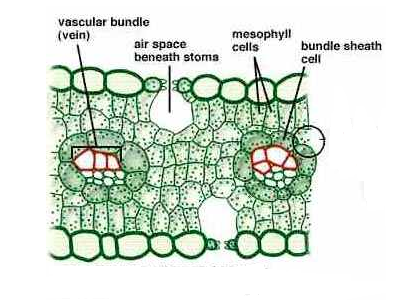
Fig.10. Kranz Anatomy
The cells of kranz anatomy are characterized by large number of chloroplast, thick walls with no intercellular spaces. The primary carbon-dioxide acceptor during C4 cycle is phosphoenol pyruvate (PEP). PEP is present in mesophyll cells. But mesophyll cells lack RuBisco. Atmospheric carbon-dioxide reacts with PEP to form oxaloacetic acid in mesophyll cells. This is then transferred to bundle sheath cells where oxaloacetic acid undergo de-carboxylation to form malic acid. The carbon-dioxide released is entered into the Calvin cycle. The malic acid formed is used for the regeneration of phosphoenol pyruvate.

Fig.11. Hatch and Slack pathway or C4 cycle
Photorespiration
Ribulose bisphosphate possess affinity for both carbon-dioxide and oxygen. Though the affinity of RuBisco is high for carbon-dioxide as compared to oxygen, sometimes RuBisco binds oxygen which decreases the carbon-dioxide fixation. Instead of forming 3-phosphoglyceric acid (3-PGA), it forms one molecule of phosphoglycerate and phosphoglycolate. This pathway is known as photorespiration. Three cell organelles are involved in photorespiration- chloroplast, peroxisomes and mitochondria.
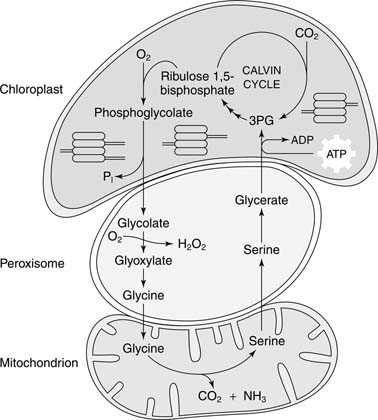
Fig.12. Photorespiration
During photorespiration, neither ATP nor sugar are synthesized. It is considered as waste process as it utilizes ATP and releases carbon-dioxide. Photorespiration is feature of C3 plants but not C4 plants. So, productivity and yield in high in case of C4 plants as compared to C3 plants. C4 plants also work efficiently during high temperature.
Crassulacean Acid Metabolism (CAM)
CAM pathway is adapted for arid conditions. In normal case, stomata are open in day time for photosynthesis. But in plants adapted for arid conditions, stomata open during night time for taking in carbon-dioxide. The carbon-dioxide is stored in the form of malate in night. The malate is fixed using PEP carboxylase similar to C4 pathway. During the night time, this malate is decarboxylated to form pyruvate. The carbon-dioxide evolved enters into Calvin cycle for carbon-dioxide fixation.
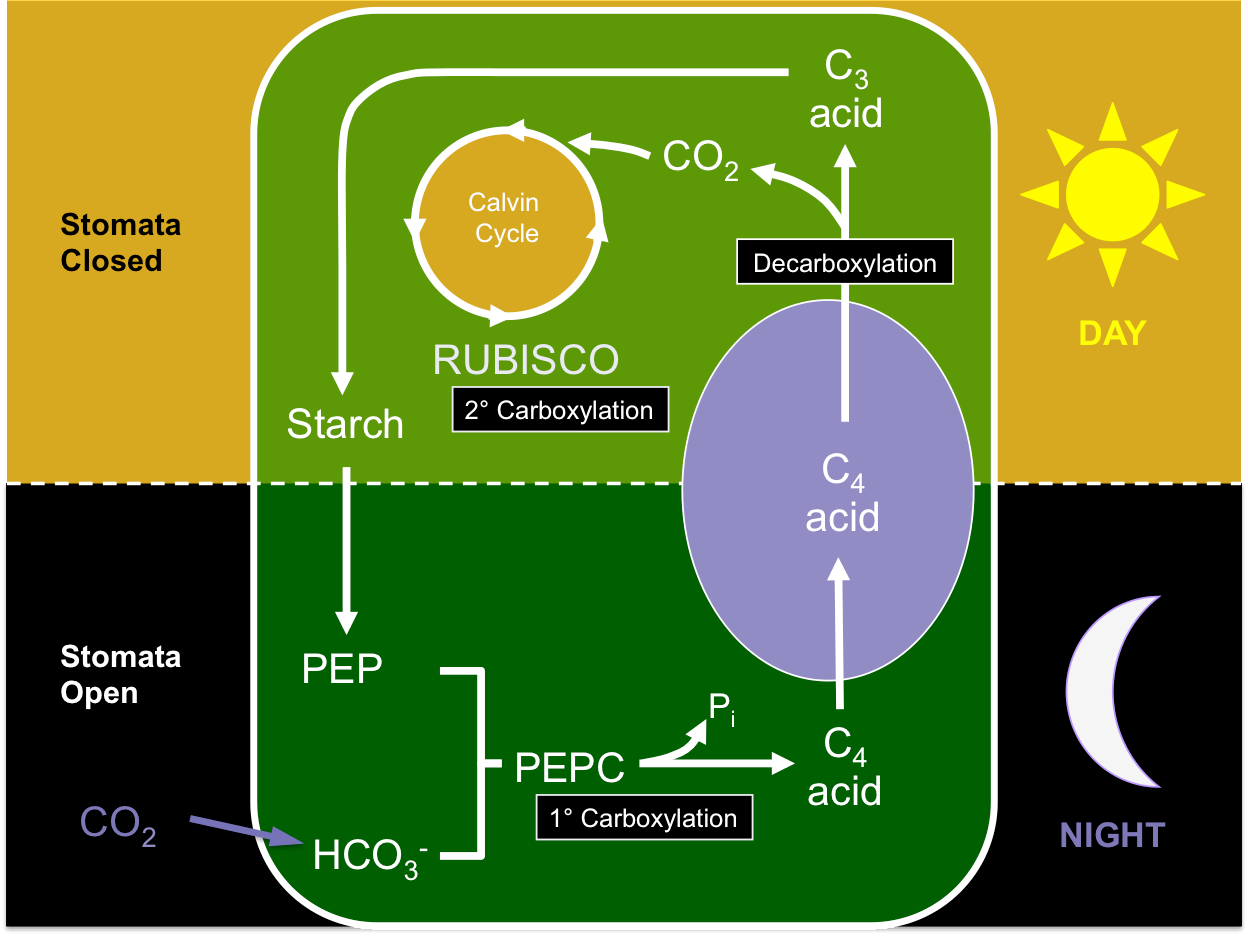
Fig.13. Crassulacean acid metabolism pathway
This pathway is advantageous for plants adapted for arid conditions. It prevents the loss of water in the form of transpiration.
Factors Affecting Photosynthesis
- Light intensity and duration of light affects the rate of photosynthesis. Increase in light intensity increases the rate of photosynthesis but after a particular intensity, rate of photosynthesis will not increase any more.
- Carbon-dioxide concentration is another factor that affects the photosynthesis. Increase in carbon-dioxide concentration increases the rate of photosynthesis but beyond 0.05% increase will cause a decrease in rate of photosynthesis. C3 and C4 plants respond differently with carbon-dioxide concentration.
- Temperature is another factor affecting the photosynthesis. Light reactions are less sensitive to temperature. C4 plants work efficiently at higher temperature as compared to C3 plants.
- Water is another limiting factor during photosynthesis. Less water closes the stomata and thus decreases the productivity of carbon fixation.
Topic 2.9: photosynthesis
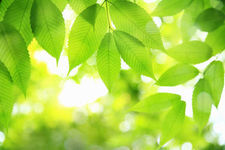
In the Photosynthesis unit we will learn how light energy is converted into chemical energy. Every living creature needs food or energy to survive. Some depend on others for food and energy, whiles others can produce their own food. Plants make their own food, glucose, in a process called photosynthesis. We say that plants can photosynthesise.
Photosynthesis and respiration go hand in hand. The result of photosynthesis is glucose, which is stored as chemical energy in the plant cells.
This stored chemical energy comes from the conversion of inorganic carbon (carbon dioxide) into organic carbon. Respiration releases the stored chemical energy.
The unit is planned to take 3 school days
Essential idea:
- Photosynthesis uses the energy in sunlight to produce the chemical energy needed for life.
Nature of science:
- Experimental design—controlling relevant variables in photosynthesis experiments is essential. (3.1)
- Define independent variable, controlled variable and responding variable.
2.9.U1 Photosynthesis is the production of carbon compounds in cells using light energy.
- Define photosynthesis.
- State the chemical equation for photosynthesis.
Photosynthesis is the fundamental process by which plants manufacture food molecules (carbohydrates) from raw materials CO2 and H2O) using energy from light.
This process requires a photosynthetic pigment (chlorophyll) and can only occur in certain organisms (plants, certain bacteria)
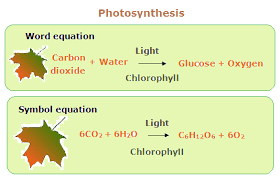
2.9.U2 Visible light has a range of wavelengths with violet the shortest wavelength and red the longest.
- Define visible light.
- State the relationship between wavelength and energy.
- State the range of wavelengths that fall within the visible spectrum.
The electromagnetic spectrum is the range of all possible frequencies of electromagnetic radiation. Sunlight/ light made up of wavelengths of electromagnetic radiation that our eyes can detect = visible to us and other wavelengths are invisible visible light = wavelengths longer than ultraviolet/ shorter than infrared / range of wavelengths of visible light is 400 to 700 nanometer.
The colours of the visible spectrum are (from longest to shortest wavelength):
Red Orange Yellow Green Blue Indigo Violet (Mnemonic: Roy G. Biv)
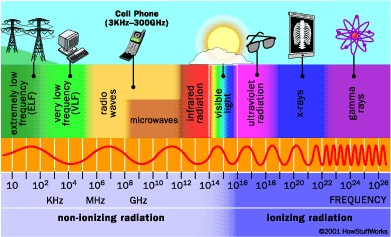
2.9.U3 Chlorophyll absorbs red and blue light most effectively and reflects green light more than other colours
- .Define pigment.
- State the primary and accessory pigments found in chloroplasts.
- Explain why plants are green.
Chlorophyll is a green pigment found in photosynthetic organisms that is responsible for light absorption. When chlorophyll absorbs light, it releases electrons which are used to synthesise ATP (chemical energy). Chemical substance called pigment involved in first step pf photosynthesis.
Chlorophyll absorbs light most strongly in the blue portion of the visible spectrum, followed by the red portion
Chlorophyll reflects light most strongly in the green portion of the visible spectrum (hence the green colour of leaves)
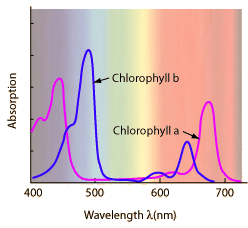
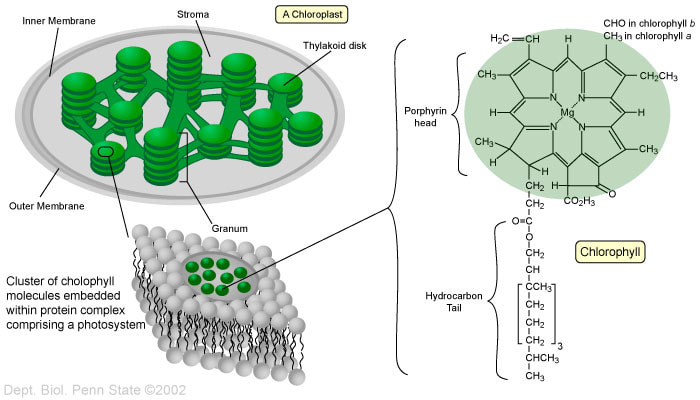
2.9.U4 Oxygen is produced in photosynthesis from the photolysis of water.
- Define photolysis.
- State the equation for photolysis.
- State that the oxygen produced in photolysis is a waste product of photosynthesis
The splitting of molecules of water to release electrons needed in other stages (photolysis)
Step 1: Light Dependent Reactions
- Light is absorbed by chlorophyll, which results in the production of ATP (chemical energy)
- Light is also absorbed by water, which is split (photolysis) to produce oxygen and hydrogen
- The hydrogen and ATP are used in the light independent reactions, the oxygen is released from stomata as a waste product
Step 2: Light Independent Reactions
- ATP and hydrogen (carried by NADPH) are transferred to the site of the light independent reactions
- The hydrogen is combined with carbon dioxide to form complex organic compounds (e.g. carbohydrates, amino acids, etc.)
- The ATP provides the required energy to power these anabolic reactions and fix the carbon molecules together
Photosynthesis Interactive Activity
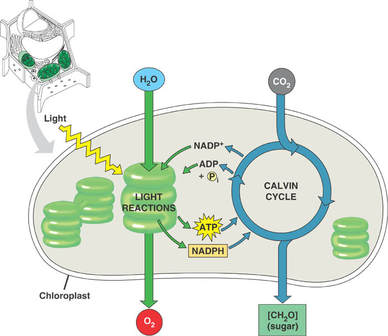
2.9.U5 Energy is needed to produce carbohydrates and other carbon compounds from carbon dioxide.
- State the energy conversion that occurs during photosynthesis.
ATP and hydrogen derived from photolysis of water are used to fix carbon dioxide to make organic molecules. Plants convert carbon dioxide into glucose through the Calvin cycle in photosynthesis. This process requires energy from light being put in and so is described as being endothermic.
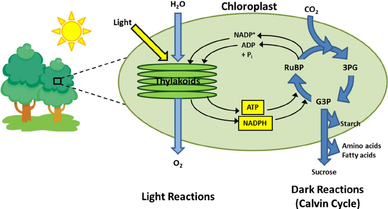
2.9.U6 Temperature, light intensity and carbon dioxide concentration are possible limiting factors on the rate of photosynthesis.
- Define “limiting factor.”
- Explain how the following factors limit the rate of photosynthesis:
- Temperature
- Light intensity
- CO2 concentration
The law of limiting factors states that when a chemical process depends on more than one essential condition being favourable, the rate of reaction will be limited by the factor that is nearest its minimum value
Photosynthesis is dependent on a number of favourable conditions, including:
- Temperature
- Light intensity
- Carbon dioxide concentration
If it gets too cold, the rate of photosynthesis will decrease as enzyme activity is low. Plants cannot photosynthesise if it gets too hot either as the enzymes controlling it are denatured. |
Without enough light, a plant cannot photosynthesise very quickly, even if there is plenty of water and carbon dioxide. Increasing the light intensity will boost the speed of photosynthesis and then the rate will become steady as something else is a limiting factor, eg temperature or carbon dioxide concentration |
Sometimes photosynthesis is limited by the concentration of carbon dioxide in the air. Even if there is plenty of light, a plant cannot photosynthesise if there is insufficient carbon dioxide. Increasing the concentration of carbon dioxide will boost the speed of photosynthesis and then the rate will become steady as something else is a limiting factor, eg temperature or light intensity. |
2.9.A1 Changes to the Earth’s atmosphere, oceans and rock deposition due to photosynthesis.
- State that (some) prokaryotes, algae and plants carry out photosynthesis.
- Define and state evidence for the “Great Oxidation Event.”
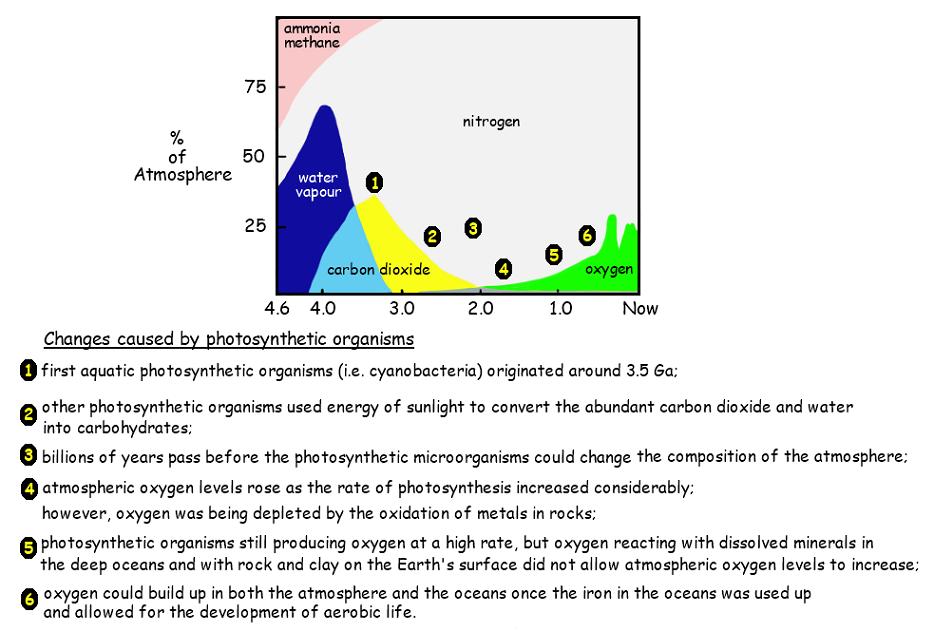
The Atmosphere On Earth.. How Did It Change
2.9.S1 Drawing an absorption spectrum for chlorophyll and an action spectrum for photosynthesis.
- Distinguish between an action spectrum and an absorption spectrum.
- Describe the shape of the curve for an absorption spectrum.
- Describe the shape of the curve for an action spectrum.
Pigments absorb light as a source of energy for photosynthesis
- The absorption spectrum indicates the wavelengths of light absorbed by each pigment (e.g. chlorophyll)
- The action spectrum indicates the overall rate of photosynthesis at each wavelength of light
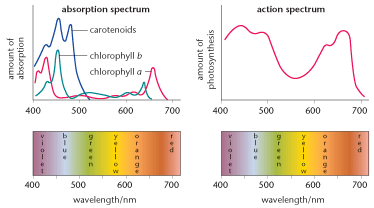
2.9.S2 Design of experiments to investigate the effect of limiting factors on photosynthesis.
- List mechanism for measuring the rate of photosynthesis
(Practical 4)
- Outline the process of separating pigments using chromatography
- Calculate the Rf value for pigments using pigment chromatography.
Paper chromatography can be used to separate photosynthetic pigments but thin layer chromatography gives better results.
Photosynthetic organisms do not rely on a single pigment to absorb light, but instead benefit from the combined action of many. These pigments include chlorophylls, xanthophyll and carotenes. Chromatography is an experimental technique by which mixtures can be separated
Two of the most common techniques for separating photosynthetic pigments are:
- Paper chromatography – uses paper (cellulose) as the stationary bed
- Thin layer chromatography – uses a thin layer of adsorbent (e.g. silica gel) which runs faster and has better separation
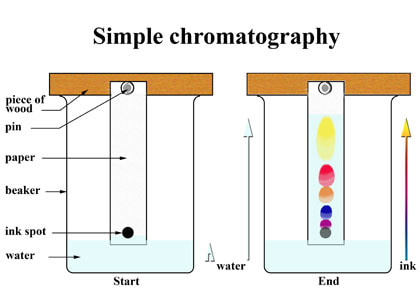
Photosynthesis
3.8.1 State that photosynthesis involves the conversion of light energy into chemical energy.
Photosynthesis involves the conversion of light energy into chemical energy.
3.8.2 State that light from the Sun is composed of a range of wavelengths (colours).
The light from the sun is composed of a range of wavelengths (colours).
3.8.3 State that chlorophyll is the main photosynthetic pigment.
Chlorophyll is the main photosynthetic pigment.
3.8.4 Outline the differences in absorption of red, blue and green light by chlorophyll.
Chlorophyll can absorb red and blue light more than green. Chlorophyll cannot absorb green light and so instead reflects it making leaves look green.
3.8.5 State that light energy is used to produce ATP, and to split water molecules (photolysis) to form oxygen and hydrogen.
Light energy is used to produced ATP and to split water molecules (photolysis) to form oxygen and hydrogen.
3.8.6 State that ATP and hydrogen (derived from the photolysis of water) are used to fix carbon dioxide to make organic molecules.
ATP and hydrogen derived from photolysis of water are used to fix carbon dioxide to make organic molecules.
3.8.7 Explain that the rate of photosynthesis can be measured directly by the production of oxygen or the uptake of carbon dioxide, or indirectly by an increase in biomass.
Photosynthesis can be measured in many ways as it involves the production of oxygen, the uptake of carbon dioxide and an increase in biomass. For example, aquatic plants release oxygen bubbles during photosynthesis and so these can be collected and measured. The uptake of carbon dioxide is more difficult to measure so it is usually done indirectly. When carbon dioxide is absorbed from water the pH of the water rises and so this can be measured with pH indicators or pH meters. Finally, photosynthesis can be measured through an increase in biomass. If batches of plants are harvested at a series of times and the biomass of these batches is calculated, the rate increase in biomass gives an indirect measure of the rate of photosynthesis in the plants.
3.8.8 Outline the effects of temperature, light intensity and carbon dioxide concentration on the rate of photosynthesis.
As temperature increases, the rate of photosynthesis increases more and more steeply until the optimum temperature is reached. If temperature keeps increasing above the optimum temperature then photosynthesis starts to decrease very rapidly.
As light intensity increases so does photosynthesis until a certain point. At a high light intensities photosynthesis reaches a plateau and so does not increase any more. At low and medium light intensity the rate of photosynthesis is directly proportional to the light intensity.
As the carbon dioxide concentration increases so does the rate of photosynthesis. There is no photosynthesis at very low levels of carbon dioxide and at high levels the rate reaches a plateau.

